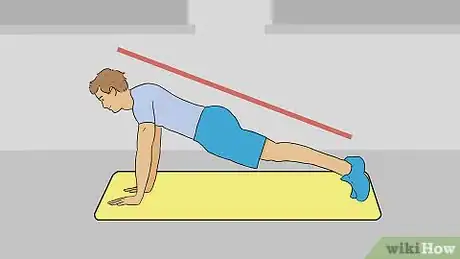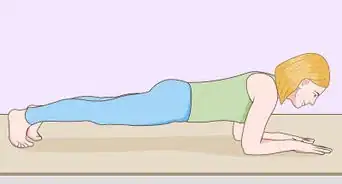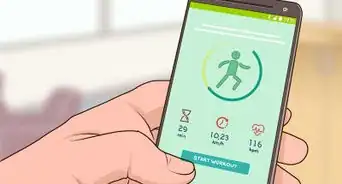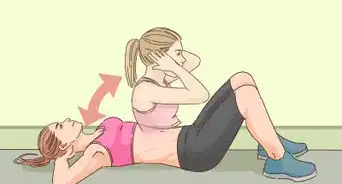This article was co-authored by Steve Horney PT, MPT, MTC, CSCS. Steve Horney is a Licensed Physical Therapist and the Owner of Integrated Health Sciences, a New York City-based company that provides continuing education, health care products, and manual and movement physical therapy. Steve has over 15 years of academic and professional physical therapy training and specializes in the assessment and treatment of athletes with the goal of helping them become pain-free and less susceptible to injury. Steve is also a certified strength and conditioning specialist (CSCS) from the National Strength and Conditioning Association (NSCA). He received a BS in Health Science from Quinnipiac University in 2004 and a Masters of Physical Therapy (MPT) from Quinnipiac University in 2006. He then completed his Manual Therapy Certification (MTC) from the University of St. Augustine in 2014.
There are 10 references cited in this article, which can be found at the bottom of the page.
wikiHow marks an article as reader-approved once it receives enough positive feedback. In this case, 96% of readers who voted found the article helpful, earning it our reader-approved status.
This article has been viewed 750,461 times.
If you cannot do a traditional push up now, do not worry. There are a variety of exercises you can do that will prepare you for traditional push ups. If you are a beginner, start with wall, tabletop or incline push ups. Once you have mastered these, move on to knee push ups and positive or negative-form push ups. Additionally, by strengthening the muscles you use to perform push ups, such as your shoulders, pectorals, and abdomen, you will be one step closer to performing traditional push ups.
Things You Should Know
- Build up your strength with beginner's pushups, like incline pushups, tabletop pushups, knee pushups, and wall pushups.
- Prepare your body for full pushups by performing lifts, like one-arm tricep extensions and forearm planks.
- Complete a full pushup by starting in a high plank position, lowering yourself to the ground, and then pushing yourself back into your starting position.
Steps
Performing Beginner Push Ups
-
1Start with wall push ups. Stand three to four feet away from a wall and face the wall. Lean toward the wall and place your hands shoulder-width apart. Slowly bend your elbows to lower yourself to the wall. Once your chest touches the wall – or nearly does so – push up until your arms are straight but slightly bent. This is one wall push up.[1]
- Do three sets of five to twenty wall push ups. Practice this three times a week.
-
2Try tabletop push ups. Place a mat on the floor. Get on your hands and knees. Your arms and back should be straight and your knees bent. Slowly lower your upper body toward the floor. Once your nose almost touches the mat, slowly push up with your arms back to the starting position. This is one tabletop push up.[2]
- Do three sets of five to ten tabletop push ups. Practice this three times a week.
- Make sure your back is straight throughout the whole exercise.
Advertisement -
3Attempt an incline push up. Place your hands shoulder-width apart on a sturdy, elevated surface like a sofa arm, bench, chair or table. Stretch your legs and place your feet straight out behind you. Your back should be straight and your body should be positioned diagonally relative to the floor. Slowly lower your upper body toward the elevated surface until your elbows are bent at a 90-degree angle. Then slowly push back up to the starting position. This is one incline push up.[3]
- Make sure your elbows are close to your body and not sticking out when performing this exercise.
- Do three sets of five to ten incline push ups. Practice this three times a week.
- The strength and conditioning community generally agrees that doing pushups on an elevated surface is a good way to work your way up to regular pushups.[4]
Making Further Progress
-
1Attempt a knee push up. Place a mat on the floor. Get on your hands and knees. Move your hands forward until your body is positioned diagonally relative to the floor. Crisscross your calves and raise your feet up until they are suspended in the air. With your back straight, slowly lower your upper body to the ground until your elbows are bent at a 90-degree angle. Then slowly push back up to the starting position. Your arms should be straight with a slight bend at the elbow. This is one knee push up.[5]
- Make sure to keep your back straight and tighten your core as you perform this exercise.
- You can place a towel or pillow under your knees to cushion them.
- Do three sets of five to ten knee push ups. Practice this three times a week.
-
2Try a negative push up. Place a mat on the floor. Start in a high plank position as if you are about to do a real push up. Do not lock your elbows; they should be slightly bent. Then slowly lower your body all the way to the ground until it is resting on the mat. This is one negative push up.[6]
- Do three sets of five to ten negative push ups. Practice this three times a week.
- Make sure to tighten your abdominal muscles while you perform this exercise.
-
3Do a positive push up. Place a mat on the floor. Lie stomach-down on the mat. Place your hands flat on the floor slightly under your chest. Slowly push up to the high plank position. Hold this position for five seconds and then lower yourself back to the ground. This is one positive push up.[7]
- Do three sets of five to ten positive push ups. Practice this exercise three times a week.
- If you cannot push yourself all the way up to the high plank position, then push up to a height you are comfortable with.
Strengthening Your Muscles
-
1Try a one-arm tricep extension. Stand straight with your feet slightly apart. Grab a dumbbell with one hand and raise it above your head. Your arm should be straight with your elbow slightly bent. Slowly lower the dumbbell behind your head until your elbow is bent at a 90-degree angle. Then slowly raise the dumbbell above your head back to the starting position. This is one extension.[8]
- Start with a three to five pound dumbbell.
- Do three sets of five to ten tricep extensions for each arm. Practice this three times a week and work up the number of reps per set to 15.
- Then, gradually increase the weight and reduce the amount of reps per set until you can only do between 6 to 10 reps with good form.
-
2Do a palms-in shoulder press. Grab two dumbbells and stand with your feet slightly apart. Raise the dumbbells to shoulder level and hold them there. Your palms should be facing each other at this point. Slowly raise the dumbbells above your head until your arms are straight with your elbows slightly bent. Then slowly lower them back down to shoulder level. This is one shoulder press.[9]
- Start with a three to five pound dumbbell.
- Do three sets of five to ten shoulder presses. Practice this exercise three times a week. As with the one-arm tricep extension, work up to 15 reps per set, then increase the weight and reduce your reps.
-
3Give a forearm plank a try. Place a mat on the floor and lie stomach-down on it. Place your forearms on the floor and raise yourself up on your toes. In this position, your elbows should be under and aligned with your shoulders. You can either place your palms flat on the floor, or clench them into fists. This is the plank position. Hold this position for 15 to 30 seconds.[10]
- Make sure your forearms are shoulder-width apart, and your feet slightly apart as well.
- Also make sure your back is straight and your abdomen tight. Your bottom should not be sagging or sticking up in the air.
- If you're having a hard time tightening your butt muscles, one trick is to imagine someone is about to kick you in that spot. This should cause you to tense your muscles.[11]
- Do three sets of 15 to 30 seconds. Practice this three times a week. Gradually try to work up to doing 3 one-minute holds.
Doing a Proper Push Up
-
1Begin in a high plank position. Place a mat on the floor and get on your hands and knees. Your arms should be straight and your hands should be positioned underneath your shoulders. Then straighten out your legs and ground your toes into the floor. Now you are in a high plank position.[12]
- Your feet should be slightly apart in the position.
-
2Tighten your abdomen and buttocks. Doing this will ensure that your back remains straight as you do your push ups. If not, then make sure your back is straight. You do not want your bottom to be sagging or sticking up in the air.
-
3Lower yourself to the ground. Slowly lower yourself to the ground until your elbows are bent at a 90-degree angle. As you lower yourself, do not look straight down. Instead, focus your eyes on a point about two to three feet ahead of you. This will help keep your neck in a neutral position. [13]
- If you have a floor-length mirror, you can do your push-ups in front of it. Look into the mirror as you lower yourself to make sure that your back is in the proper position the whole time.[14]
- Breathe in as you lower yourself to the ground.
-
4Push back up. Do this once your elbows hit the 90-degree angle. Slowly push back up to the starting position. Congratulations, you just completed one push up! Start with three sets of five to eight push ups. Practice this three times a week.[15]
- Remember to keep your back straight as you push up.
- Exhale as you push back up.
Push-Up Variations, Exercises, and Workout Schedule
Expert Q&A
Did you know you can get expert answers for this article?
Unlock expert answers by supporting wikiHow
-
QuestionI have osteoarthritis and have to look after my damaged joints. Neither my wrists nor my knees can support my weight. Would a forearm plank or a wall push up do the trick?
 Michele DolanMichele Dolan is a BCRPA certified Personal Trainer in British Columbia. She has been a personal trainer and fitness instructor since 2002.
Michele DolanMichele Dolan is a BCRPA certified Personal Trainer in British Columbia. She has been a personal trainer and fitness instructor since 2002.
Certified Fitness Trainer
-
QuestionDo push-ups help build muscle?
 Michele DolanMichele Dolan is a BCRPA certified Personal Trainer in British Columbia. She has been a personal trainer and fitness instructor since 2002.
Michele DolanMichele Dolan is a BCRPA certified Personal Trainer in British Columbia. She has been a personal trainer and fitness instructor since 2002.
Certified Fitness Trainer
-
QuestionDo push-ups against a wall work?
 Michele DolanMichele Dolan is a BCRPA certified Personal Trainer in British Columbia. She has been a personal trainer and fitness instructor since 2002.
Michele DolanMichele Dolan is a BCRPA certified Personal Trainer in British Columbia. She has been a personal trainer and fitness instructor since 2002.
Certified Fitness Trainer
References
- ↑ http://www.self.com/story/upper-body-exercises-to-try-if-you-cant-do-a-push-up
- ↑ http://dailyburn.com/life/fitness/how-to-do-a-push-up-variations/
- ↑ http://dailyburn.com/life/fitness/how-to-do-a-push-up-variations/
- ↑ Steve Horney PT, MPT, MTC, CSCS. Licensed Physical Therapist. Expert Interview. 27 March 2020.
- ↑ http://dailyburn.com/life/fitness/how-to-do-a-push-up-variations/
- ↑ https://breakingmuscle.com/fitness/how-to-progress-your-way-to-a-perfect-push-up
- ↑ https://breakingmuscle.com/fitness/how-to-progress-your-way-to-a-perfect-push-up
- ↑ https://dumbbell-exercises.com/exercises/triceps/
- ↑ https://dumbbell-exercises.com/exercises/shoulders/
- ↑ https://greatist.com/fitness/perfect-plank
- ↑ Steve Horney PT, MPT, MTC, CSCS. Licensed Physical Therapist. Expert Interview. 27 March 2020.
- ↑ https://greatist.com/fitness/how-do-perfect-push
- ↑ https://www.nerdfitness.com/blog/proper-push-up/
- ↑ Steve Horney PT, MPT, MTC, CSCS. Licensed Physical Therapist. Expert Interview. 20 March 2020.
- ↑ https://greatist.com/fitness/how-do-perfect-push
About This Article
To prepare to do push ups even if you can’t now, try wall push ups. Stand facing a wall, place your hands shoulder-width apart, and bend your elbows to lower your chest to the wall. You can also do dumbbell exercises that build arm strength, such as 1-arm tricep extensions. As you progress, try a knee push up. Get on your hands and knees and move your hands forward until your body is diagonal to the floor. Then, with a straight back lower your body to the ground. For tips from our personal trainer reviewer on how to do a proper push up, keep reading!
















-Step-4.webp)
















































